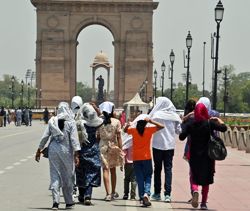
IRONY: Despite bumper harvests year after year, Indian farmers have been suffering losses. PTI
Devinder Sharma
Food & Agriculture Specialist
AN elderly woman living alone in a village didn’t have any viable livelihood option. She finally decided to buy a goat for a living. Since nationalised banks do not provide small loans, she approached a micro-finance institute (MFI) for a loan in the range of Rs 8,000 to Rs 10,000. She got a loan at an interest rate of 20-24 per cent, to be paid back at monthly intervals.
On the other hand, when Tata Motors decided to shift the manufacturing of its Nano cars from West Bengal to Gujarat, the then BJP government in Gujarat extended a soft loan of
Rs 584.82 crore at an interest rate of 0.1 per cent. As per the lending provisions, this loan was to be repaid back in monthly instalments 20 years after the first Nano car was rolled out.
If only the elderly woman had got the small loan at an interest rate as low as 1 per cent (forget 0.1 per cent that Tata Motors got), I am sure she would have been driving a Nano car by the year-end. I have narrated the story to explain how inequality is woven into the economic system. Whether we like it or not, wealth has traditionally been very conveniently sucked from the bottom to the top. And we have no qualms about it.
Although many academics laud the MFIs for extending small loans that help in capacity-building of the people living at the margins, they go conspicuously quiet when big businesses are extended huge loans at almost negligible interest rates. This makes me wonder why abnormally high rates of interest for a meagre loan only help in capacity-building of the poor. Why is it that the rich, who have the capacity to pay back, end up receiving massive loans virtually as a grant? Add to it the numerous tax breaks, bank write-offs at the drop of a hat, generous economic stimulus packages, government contracts and the other incentives for growth; in reality we have socialism for the corporate.
It is only the average citizen and the poor who are left to face the vagaries of the markets. This is because the rich design the markets, and the markets work for them. A recent media advisory by Oxfam illustrates this anomaly. The world’s biggest chocolate manufacturers — Ferrero and Mars families — have more wealth than even the combined GDP of Ghana and Ivory Coast, which supply 60 per cent of the cocoa beans. And instead of paying an economic and profitable price to farmers, the world’s top four chocolate giants (including the two mentioned above) have in 2023 paid out 97 per cent of their net profits to shareholders. Ghana and Ivory Coast receive only 6 per cent of the total revenue of $160 billion that the industry makes. Ask for a Minimum Support Price (MSP) for these growers, and an uproar will happen, warning how it will distort markets.
That’s how rigged the economic design is. In other words, the financial system actually helps provide wealth on a platter to the so-called wealth creators. In the digital age, we don’t even realise that algorithms are designed to ensure that wealth flows sustainably to the top.
Former US Secretary for Labour Robert Reich says that the combined wealth of the world’s billionaires at $14.2 trillion now exceeds the GDP of every country in the world, except America and China. In America, 400 billionaires collectively hold $5.8 trillion, which exceeds the entire wealth of the 65 million people in the bottom half. And still worse, billionaires have a lower effective tax rate than what the average working American pays. Giving massive tax breaks to the rich hasn’t trickled down to the poor, as we were told. While the tax sops hasn’t created additional employment nor has it boosted industrial output as was envisaged, it has certainly boosted the pay packets of CEOs and other high-paid workers by several times. In addition, corporations have used the profits generated to buy back stocks. For instance, Apple has announced $110-billion stock buyback, the largest ever.
The World Inequality Lab, in a working paper titled ‘Income and Inequality in India, 1992-2023: The Rise of Billionaire Raj’, had conclusively shown how inequality had worsened over the decades and is presently among the highest in the world. A report by the Centre for Monitoring of Indian Economy shows how personal tax collections now exceed corporate tax as percentage of the GDP. This is at a time when the top 1 per cent holds more than 40 per cent wealth. The bottom 50 per cent collectively owns only 3 per cent. What has to be understood is that it is not as if the poor don’t work hard but they are denied the right kind of financial support and investment.
Take the case of agriculture. Despite bumper harvests year after year, if Indian farmers have been cultivating losses since 2000 (as per an OECD report), it only shows how inadequate the budgetary support has been for farming. If you don’t make the right kind of investment, you can’t expect a miracle to happen. Of the Rs 48 lakh crore Budget expenditure spelt out for 2024-25, agriculture gets only Rs 1.25 lakh crore, which is less than 3 per cent. With roughly 50 per cent of the population dependent on agriculture, and without appropriate redistribution of resources, Sabka Saath, Sabka Vikas will remain an empty slogan.
Economist Jean Dreze recently summed it up neatly: “If a hundred workers were to work day after day at the minimum wage and save their entire earnings, how long do you think it would take for them to accumulate as much wealth as India’s richest business leader already has? Answers rarely cross a thousand years. The correct answer, however, is close to a million years. If you do not believe it, do the math.”
Join Whatsapp Channel of The Tribune for latest updates.




























